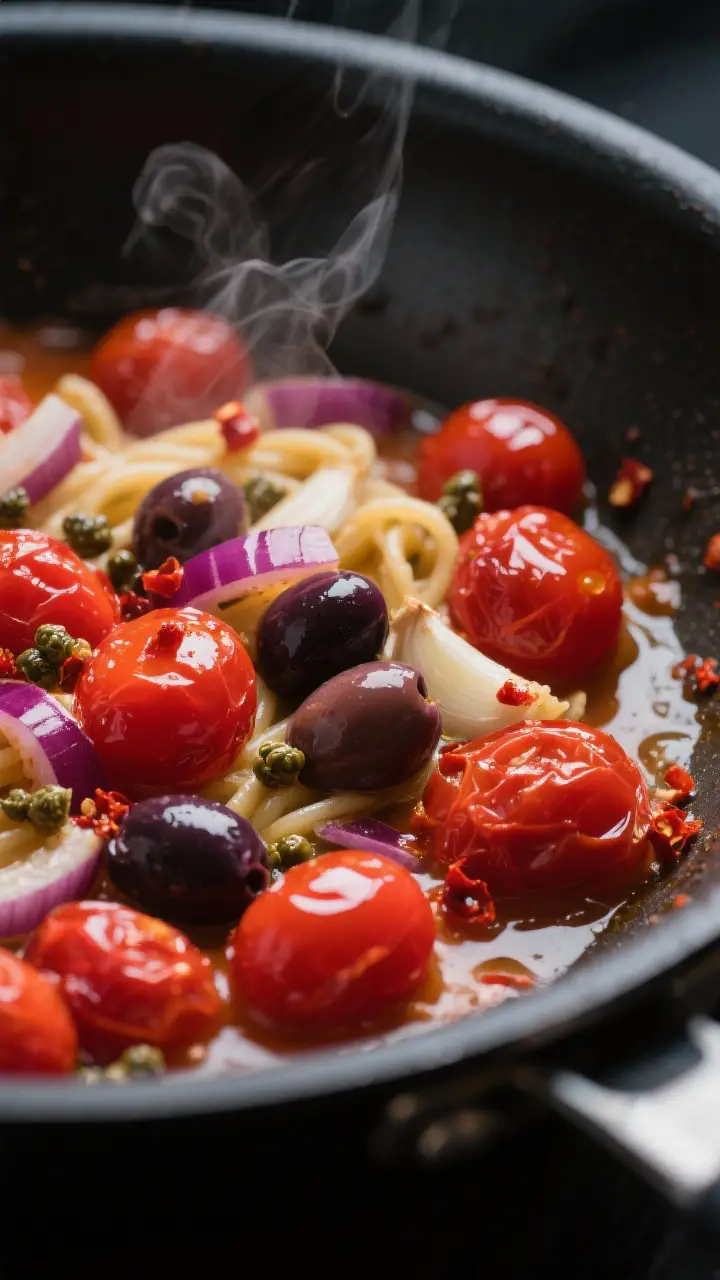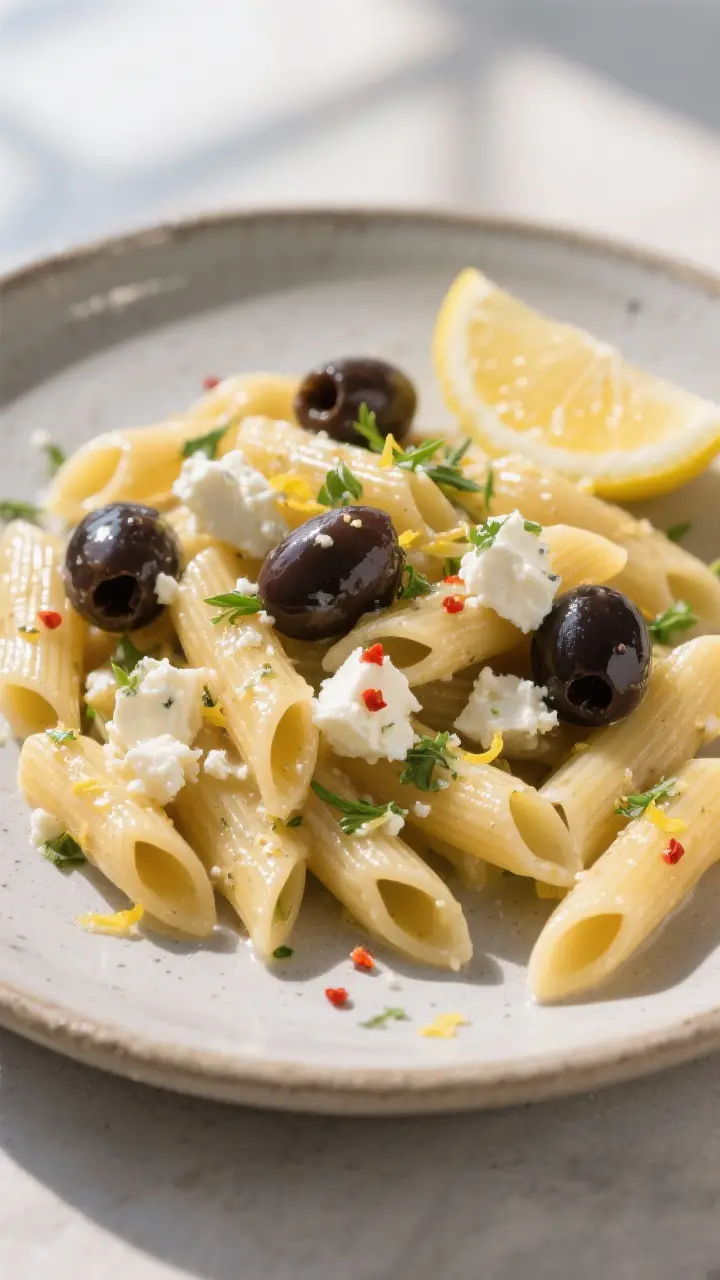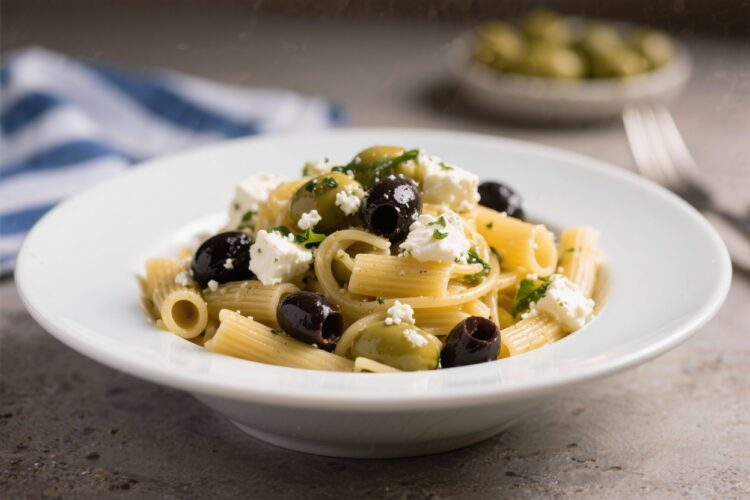This Greek-inspired pasta delivers bold flavor with minimal effort. Briny Kalamata olives, creamy feta, juicy tomatoes, and fresh herbs come together in a simple sauce that tastes like summer. It’s quick enough for a weeknight but special enough to share.
The whole dish is ready in about 30 minutes, with just one pot for pasta and one skillet for the sauce. If you like fresh, clean flavors, this one’s a keeper.
What Makes This Special

This dish balances salty, tangy, and fresh elements in a way that feels effortless. You get the savory punch of olives and capers, the creaminess of feta, and the brightness of lemon and herbs.
It’s fast, flexible, and uses pantry staples you might already have. Best of all, it holds up well at room temperature, so it’s great for picnics or potlucks.
Ingredients
- 12 ounces (340 g) pasta such as penne, fusilli, or spaghetti
- 3 tablespoons extra-virgin olive oil
- 3 cloves garlic, thinly sliced
- 1 small red onion, thinly sliced or finely chopped
- 1 pint cherry or grape tomatoes, halved (or 2 cups chopped ripe tomatoes)
- 1/2 cup pitted Kalamata olives, halved
- 1 tablespoon capers, drained (optional but recommended)
- 1/2 teaspoon red pepper flakes (adjust to taste)
- 1 lemon (zest and juice)
- 3–4 ounces (85–115 g) feta cheese, crumbled
- 1/4 cup fresh parsley, chopped
- 2 tablespoons fresh oregano, chopped (or 1 teaspoon dried oregano)
- Salt and freshly ground black pepper, to taste
- 1/2 cup reserved pasta cooking water (approximate)
- Optional add-ins: baby spinach, roasted red peppers, cucumber (for serving cool), or grilled chicken
Step-by-Step Instructions

- Boil the pasta. Bring a large pot of salted water to a boil. Cook the pasta until just shy of al dente.
Scoop out about 1 cup of the starchy cooking water, then drain the pasta.
- Sauté the aromatics. In a large skillet, warm the olive oil over medium heat. Add the red onion and cook until soft and translucent, about 4 minutes. Stir in the garlic and red pepper flakes and cook 30–60 seconds, until fragrant.
- Build the sauce base. Add the tomatoes and a pinch of salt.
Cook, stirring occasionally, until the tomatoes slump and release their juices, 3–5 minutes. You’re looking for a light, juicy sauce, not a thick one.
- Add olives and capers. Stir in the Kalamata olives and capers. Cook for 1 minute so the flavors mingle.
Taste and adjust salt; olives and capers are salty, so go lightly.
- Loosen with pasta water. Add a splash of reserved pasta water to create a silky sauce. You may not need all of it—start with 1/4 cup and add more as needed.
- Toss in the pasta. Add the drained pasta to the skillet and toss to coat. Keep the heat on low and stir for 1–2 minutes so the pasta absorbs the flavors.
- Finish with lemon and herbs. Turn off the heat.
Add lemon zest, a squeeze of lemon juice, parsley, and oregano. Toss again and taste. Add more lemon, pepper, or pasta water to get a glossy, bright finish.
- Add feta last. Gently fold in the crumbled feta.
It should soften a bit but not fully melt. If you like it creamier, add a touch more warm pasta water and toss for another 30 seconds.
- Serve. Drizzle with a little extra-virgin olive oil and crack fresh pepper on top. Add extra herbs and a bit more feta if you like.
Keeping It Fresh
This pasta tastes great warm, at room temperature, or chilled.
If you plan to serve it later, hold back a little feta and herbs and add them right before serving to keep everything bright. Store leftovers in an airtight container for up to 3 days.
When reheating, add a splash of water or olive oil to loosen the sauce. For a cold pasta salad vibe, toss in chopped cucumber and a touch more lemon juice just before eating.

Why This is Good for You
- Heart-healthy fats: Olive oil and olives provide monounsaturated fats that support cardiovascular health.
- Protein and calcium: Feta offers protein and minerals, and a little goes a long way for flavor.
- Fiber and antioxidants: Tomatoes, onions, and herbs bring vitamins, fiber, and polyphenols.
- Balanced energy: Pasta gives steady fuel, especially if you choose whole wheat or legume-based shapes.
What Not to Do
- Don’t overcook the pasta. It should be al dente so it holds up to the sauce and leftovers.
- Don’t oversalt early. Olives, capers, and feta are salty.
Season in layers and taste as you go.
- Don’t skip the lemon zest. It adds brightness that lifts the whole dish without adding more salt.
- Don’t cook the feta too long. Add it at the end so it stays creamy and distinct.
- Don’t drown it in sauce. This is a light, glossy coating, not a heavy red or cream sauce.
Variations You Can Try
- Green boost: Fold in a few handfuls of baby spinach at the end. The heat will gently wilt it.
- Roasted red pepper: Add strips for sweetness and color. They pair beautifully with olives and feta.
- Seafood twist: Toss in sautéed shrimp or flaky canned tuna for extra protein.
- Herb swap: Use dill and mint instead of oregano and parsley for a softer, garden-fresh flavor.
- Whole wheat or gluten-free: Use your preferred pasta; just watch the cook time and texture.
- Creamier finish: Stir in a spoonful of Greek yogurt off the heat for a tangy, silky sauce.
- Veg-forward: Add blistered zucchini rounds or roasted cherry tomatoes for extra vegetables.
FAQ
Can I make this ahead?
Yes.
Cook and toss the pasta with the sauce, then let it cool. Add the herbs and feta just before serving for the best texture and flavor. If it seems dry, stir in a splash of water, olive oil, or lemon juice.
What kind of olives work best?
Kalamata olives are classic for their rich, fruity flavor.
If you prefer something milder, use Castelvetrano. Always use pitted olives for easier eating and slicing.
How do I make it dairy-free?
Skip the feta and add toasted pine nuts for richness and crunch. A few extra capers or a drizzle of good olive oil can help replace the salty, creamy notes.
Which pasta shape should I choose?
Short shapes like penne, fusilli, or rotini trap bits of tomato and feta nicely.
Long strands like spaghetti or linguine also work if that’s what you have. The key is cooking to al dente.
Is it spicy?
Only lightly, from the red pepper flakes. Adjust to taste or omit them completely.
A pinch of black pepper can add warmth without heat.
Can I add protein?
Absolutely. Grilled chicken, shrimp, or chickpeas mix in well. Add them at the end so they stay tender and don’t overcook.
What if my tomatoes aren’t very sweet?
Add a pinch of sugar or an extra splash of olive oil to round out the acidity.
A bit more lemon zest (not juice) can brighten without increasing sourness.
In Conclusion
Greek Pasta with Olives and Feta is simple, bold, and endlessly adaptable. It comes together fast, relies on staple ingredients, and tastes great warm or chilled. Keep it light and lemony, finish with fresh herbs, and let the feta and olives do the heavy lifting.
This is the kind of weeknight dinner that feels like a treat, with flavors that stay bright from the first bite to the last.
Printable Recipe Card
Want just the essential recipe details without scrolling through the article? Get our printable recipe card with just the ingredients and instructions.

